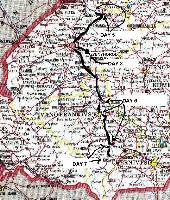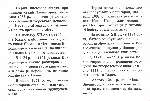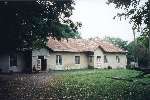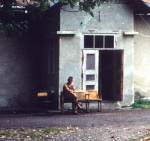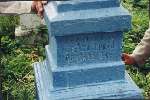|
Introduction |
TRIP TO UKRAINE
|
||
|
Sunday, September 26, 1999 Our mission this day was on behalf of Dad's sister Olga, whose deceased husband Onufry Sokil was from the village Zvenyhorod, about 15 km southeast of L'viv, and another important historical site related to the founding of L'viv. We started by picking up Orest and his son Vitali in L'viv. Orest's mother is Onufry's niece. Not only was Dad close to his sister Olga (since deceased), he owes a great debt of gratitude to Onufry, who always championed Dad's educational ambitions, and was instrumental in getting Dad's father to allow his son to leave the farm behind and make a new life in the U.S. |
|||
|
We stopped at a flower market on the edge of L'viv, so Orest could buy flowers for his father's grave. This marker designates the boundary of L'viv, with the city symbol, the lion (Lev = lion). |
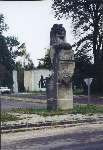
|
||
|
At the point where we turned off to the village, a monument to Danilo, founder of Zvenyhorod, and father to Lev, founder of L'viv.. |
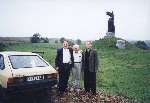
|
||
|
Entering Zvenyhorod, this beautiful restored church in traditional regional style, and a recent statue of Taras Shevchenko, father of Ukrainian nationalism. |
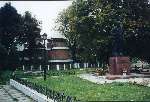
|
||
|
Monument to the end of serfdom in this area, in 1848. |
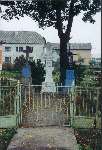
|
||
|
Arriving in Zvenyhorod, we stopped at the home of a cousin of Orest's. The Sokil name has died out, but Onufry's father is still remembered and honored - he was mayor, and sponsored a new church and a school for the town, both of which remain. The women were making pyrohy, but stopped to receive us. Zvenyhorod is home to a musuem complex built to commemorate its history as the site of one of the earliest settlements and the original seat of government in the area. We were about to pile into our car and drive to the museum, which was just a couple of blocks away - I said "Why not walk?" So we did. I learned why not, as the street was coated with various sorts of animal dung, and one could not avoid stepping in it. Ah, the joys of rural life! |
|||
|
The Soviets built his huge museum complex here, in a village of 500. A visit was obligatory. |
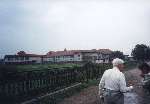
|
||
|
Huge monument, with statue of Danilo (seated at right), his son Lev (with sword and shield, at left), and man, woman and child to symbolize the strong peasant workers! |
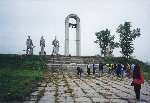
|
||
|
Another view of the central plaza of the museum complex. I did not learn the function of all the other buildings in the complex. There were many. |
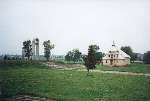
|
||
|
Inside the museum, Zvenyhorod as it might have looked shortly after it was founded, in the 12th century. |
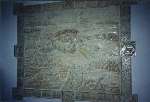
|
||
|
Panorama of a famous battle in 1241 against the Turks, in which Zvenyhorod was destroyed. |

|
||
|
This huge complex is now little-used, starting to decay. Soviet-style "planning" scores again. |
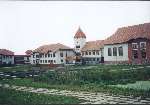
|
||
|
Front and back of a souvenir card I bought at the museum. The text translates as follows:
|

|
||
|
The old school, built when Onufry's father was mayor, circa 1910 (?) |
|||
|
Gravestone of a Sokil - sibling or cousin of Onufry. |
|||
|
Other interesting graves, more recent. |

|
||
|
The oldest markers in this cemetery are these, about 500 years old, and identified by their shape as marking Cossack graves. |
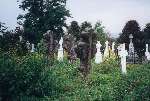
|
||
|
Back at the home of Orest's relatives, an elaborate meal was served. When I pulled out my camera, everyone changed from work clothes to Sunday best in about two minutes. |
|||
|
Two sisters. The one on the right is now mayor of the town. |
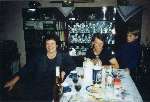
|
||
|
The girl on Dad's lap was celebrating her 8th birthday. |
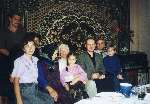
|
||
|
The mother of the two sisters - her husband died earlier in the year, and her health is now failing. Medical care is very poor now - Vitali described hospitals as prisons, and death houses. I read that one must provide all one's own bedding, food, medicine, and nursing care. All the hospital provides is a bed. |
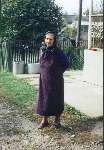
|
||
|
More kittens. |
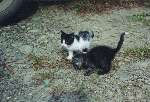
|
||
|
The lineup as we prepared to leave. |
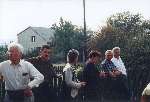
|
||
Send feedback to the author: CLICK HERE
Created -- 03/22/2007 Revised -- 03/22/2007
